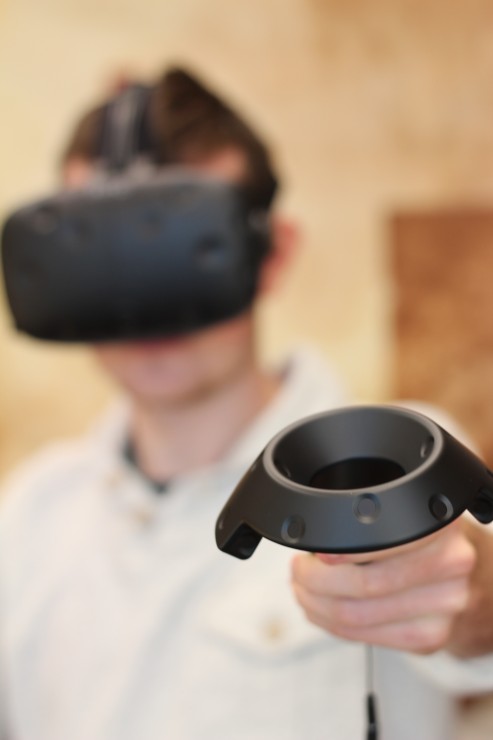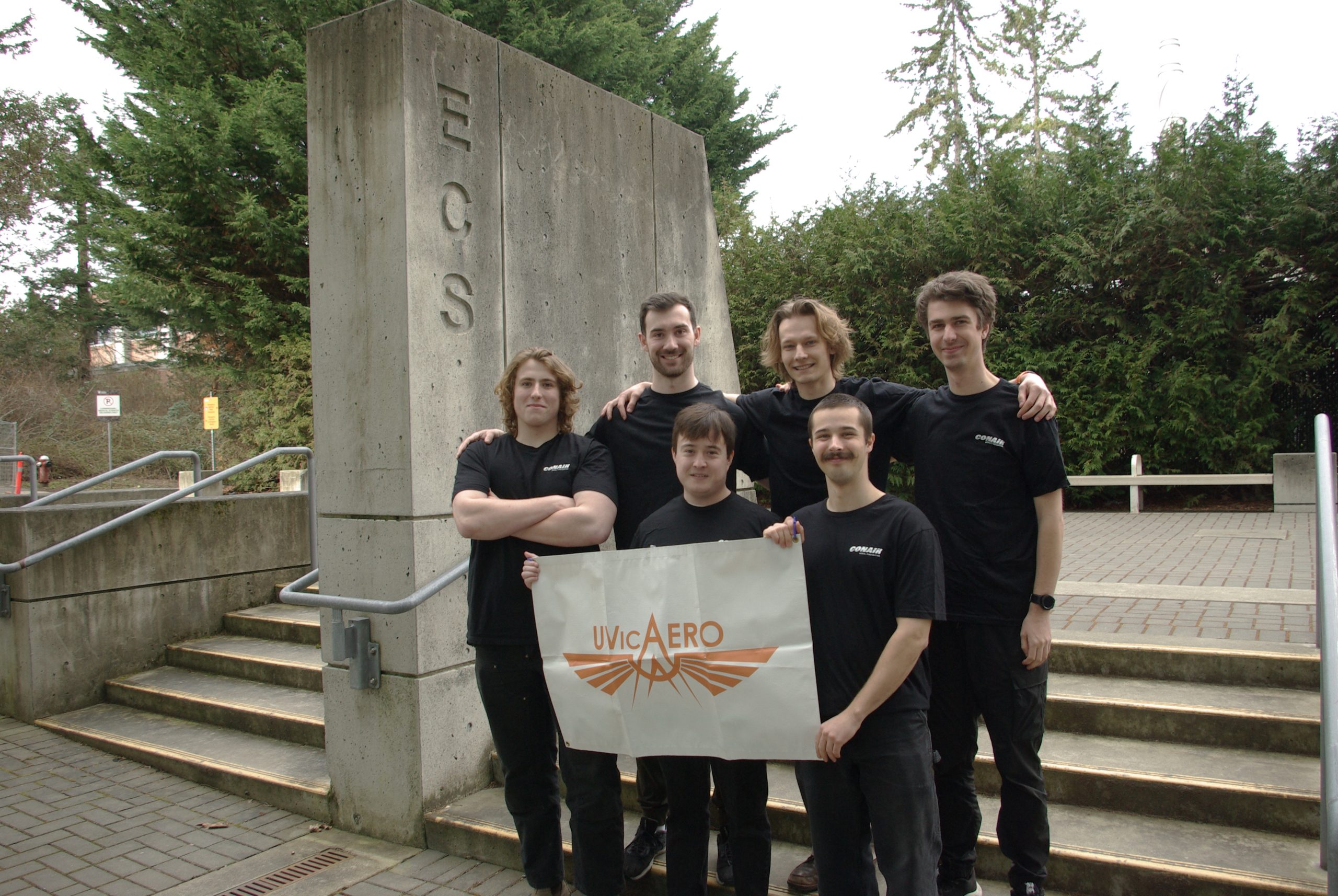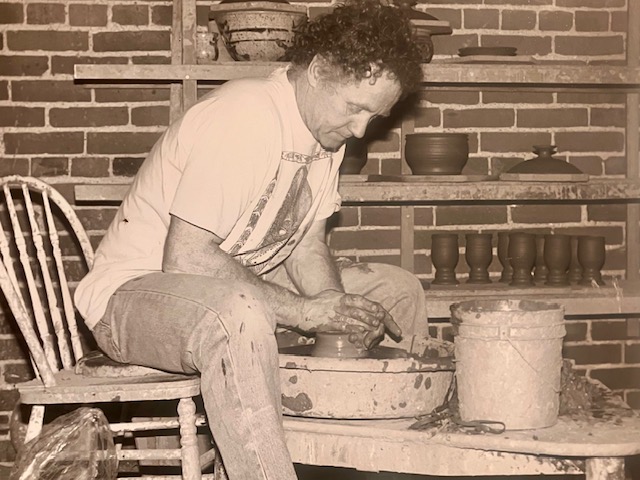
The HTC Vive is one of many products available that offer virtual reality experiences. Photo by Myles Sauer, Editor-in-Chief
START
You’re diving underwater with a pod of orcas. You’re flying through space with a jetpack and a laser gun. You’re ducking beneath the crack of gunfire in an Iraqi warzone.
And then you take your virtual reality headset off.
Virtual reality (VR) is not a new invention. It started—as so many new technologies do—as a pipe dream in science fiction. Star Trek had the holodeck, a closed room that could simulate people and environments, and films like Total Recall and The Matrix are based entirely on the idea of simulated reality. But as the technology becomes more commonplace, the space it occupies in society expands as well. Now, what once fell under the blanket term ‘virtual reality’ has expanded to include 360° videos—in which viewers can choose where the camera is pointing—and augmented or layered reality—where devices combine what the built-in camera sees with a virtual world, like in Pokémon Go. What was once limited to the realm of video games is now used in education, art, and therapy, especially in tech-savvy cities like Victoria.
Is this cutting edge of tech innovation what the future looks like? The Martlet ventured out to talk to the people who are using this technology in their respective industries to find out. We spoke to filmmakers, entrepreneurs, scuba divers, and therapists, with the goal of understanding virtual reality and how it will play into the future of our increasingly technology-based society.
For some, the technology offers an effective way to enhance the work they were already doing. For others, it affords brand new opportunities for their endeavors.
ENTERTAINMENT
It’s no surprise that the video game industry has taken to VR technology like a virtual duck to virtual water. The prospect of full immersion is massive for an industry that seeks the most addictive experience possible. As video game developer and VR arcade owner Shealand Keais explains, game developers have been pushing for proper virtual reality gaming for years.
“VR has been around since Atari [in 1972],” Keais says, “but back then it was just the red/green 3D technology . . . and you would turn your head but there was no tracking [the movement of your head]. It was just a screen.”
Things have improved immeasurably since then. Keais’ first introduction to modern VR equipment was earlier this year at a friend’s house, with a device called the HTC Vive. The Vive is a big black plastic set of goggles accompanied by two motion tracker joysticks. Keais played some games with the device and was quickly enamoured.
“Up until this point I sort of thought VR was a fad…[but] I tried it, and the next day I ordered one,” laughs Keais. “[One] moment that was like ‘holy shit’ was when I went to put down my hand controller on a table that was in the game, and I dropped it on the floor because I forgot that there was not actually a table in real life. So after that I was like, ‘OK, I need one of these.’”
Keais bought several more Vives and set up a multiplayer arcade for people wanting to play VR video games. The arcade, named Vic VR, is located just off Hillside Avenue, and is the second of its kind in Canada. Keais says the reaction has been overwhelmingly positive so far—minus a few instances of motion sickness.
Shooter games are particularly popular within VR, ranging from cartoony paint gun fights to futuristic laser shootouts. While most games are made by independent developers with a passion for the fledgling technology, companies like Disney are now beginning to invest money and develop games for devices like the Vive.
For Keais, the beauty of VR is in its realism. He doesn’t believe we’re close to virtual reality that can be mistaken for real life—“We’re probably 50 years away from that, at least,” he says—but the emotions that the technology can elicit are as real as it gets.
“There’s this chatroom game [you can use] when you’re sitting at home, late at night, and you’re feeling kind of anti-social,” Keais says. “I went into this game and I was having conversations with people and I was starting to get some social anxiety . . . you can hear their voice . . . you can see their body language . . . it’s convincing enough that you can start to feel like you’re in a real conversation with somebody.”
Keais laughs. “It’s awesome.”
EDUCATION
Beyond entertainment, VR also has the potential to educate. The Fish Eye Project, a local diving and tech start up company, uses the technology to bring the ocean to classrooms and theatres through their underwater live dives.
“Our mission is to engage kids, [and] engage everybody with the ocean using interactive technologies,“ says Maeva Gauthier, Fish Eye co-founder. “We want to educate but also entertain.”
On June 8, 2016, World Oceans Day, Gauthier and fellow co-founder Mike Irvine showcased the ocean in IMAX at the Royal B.C. Museum. During their live dive in the Emerald Forest off of Ogden Point, audiences followed the team of divers via a livestream. The dives, geared toward younger students, are a light-hearted look at the oceans around Victoria.
“[We are] using more the ‘ocean optimism’ approach with Fish Eye,” says Gauthier. “We already feel there is a lot of doom and gloom out there.”
After the success of the live dive, Irvine, a UVic graduate, and Gauthier have plans for more advanced ways of showing off the ocean: live 360° dives where viewers can choose where they’re looking. Fish Eye Project has begun forming partnerships to pull this off, planning on having the public demonstrations ready by summer, 2017.
Irvine has also been dabbling with the possibility of using VR technology in their dives, allowing users to look around and explore certain spaces on their own while receiving information about their surroundings. While some VR games have already utilized the oceanscape, like video game theBlu, Fish Eye sees the education component as key.
“It’s an enhancement tool. If it’s used properly, you can actually use it as a catalyst to get you hooked and interested, which is much what our live dives do,” says Irvine.
“We have this model where it’s like, ‘if it works under water, it works on land, it works in the sky, it works in space,’” says Irvine. “So we’ve at least tested for three, we just haven’t done the space one yet. We know [we] can do it.”
The use of VR would primarily be used as a tool for Fish Eye to get people interested in ocean welfare, rather than the main focus of their business. Even so, Irvine doesn’t doubt that VR will be used as a supplementary tool in most classrooms over the next five to 10 years, because of its potential to provide (virtual) experiential learning.
“With the right type of content or narrative, you can teach people some pretty dense topics and they’ll grab it. It’s interesting to see where we can be going with this technology,” says Irvine.
NEGATIVES
Despite the exciting potential that comes with the use of VR technology, there are plenty of people who are wary of the possible consequences. If you’ve ever watched Black Mirror, you know that irresponsible use of this ‘fake reality’ has the potential to take society to a dark place. But with VR’s widespread use only just gaining traction as affordable consumer hardware becomes available, it’s difficult to pinpoint the negative impacts at such an early stage.
Jason MacNaughton is the founder of ThisIsMeInVR, a Victoria-based company working with VR and 360° video. He’s been working within this sphere for six years now and worries that the excitement that comes with the technology is obscuring the downsides.
“At every VR meetup [people] are raving about VR,” MacNaughton says. “No one wants to talk about the nausea. No one wants to talk about the vertigo. I can tell you right now, if you spend more than an hour in a VR environment, when you get out, don’t drive a car. No one will say that, because it damages the VR industry, but the reality is there are some major side effects.”
Despite his concerns, MacNaughton doesn’t see a fundamental benevolence or malevolence to VR technology—it’s entirely up to how it is used.
“It’s a tool, like a knife,” he says. “A knife in the hands of a doctor is a scalpel, but in a criminal’s [hand], it’s bad.”
For MacNaughton, the onus lies on people to be honest and realistic about the potential pitfalls that could come with VR.
“The truth is that there are positives and negatives to everything, and as long as we are willing to openly discuss the negatives [of VR], then we can mitigate them,” he says. “[But] by ignoring the negatives, you’re really just amplifying the industry, and then those negatives will bite you in the ass later.”
HEALTH
The thought of VR in everyday life may make some people anxious, but psychologists at Vancouver Island Psychological Services (VIPS) in Victoria have found the opposite to be true: they use VR technology to help people overcome their anxieties.
Like Fish Eye, psychologists at the VIPS office use VR as a complementary tool, rather than a main technique for therapy. Through multiple sessions of explorative conversation, they first assess the patient, finding the kinds of situations that would induce anxiety, and at what level. VR is implemented only once clients recognize the source of their anxiety and have developed coping mechanisms with the psychologist.
“[We] try to simulate whatever it is they’re afraid of, to decrease the anxiety that comes up when they’re in those sorts of situations,” says Tanna Mellings, a clinical psychologist at VIPS. “We want people to see that even when that anxiety [level] jumps up quite high, it will go away.”
While the decade-old tech that VIPS uses is slightly dated in comparison to the new Oculus Rift or HTC Vive, the effect is the same—suddenly, the user travels from the psychologist’s office to another place. VIPS offers many anxiety-inducing scenarios for their clients to work through such as flying, heights, and driving, as well as specific scenarios such as combat zones in Iraq or a re-creation of 9/11.
In addition to the visual and audio components of VR, their services also have a ‘4D’ effect—a rumble chair that corresponds to the scenario occurring in the goggles. For example, the bottom of the chair slowly quivers as the plane takes off, or the side of the chair shakes if your truck hits an improvised explosive device in Iraq.
This type of exposure therapy works in conjunction with a hierarchy of triggers (bad weather, a bumpy landing) for the client, and can accustom them to situations that they might not be able to avoid like a mandatory business fight.
For psychologist Lise McLewin, who works with children and teenagers, it’s especially important for her that parents are careful with how much they expose their children to this type of technology. In particular, it will be important that certain games are rated for certain audiences, to provide parents with appropriate guidelines for what content the child sees.
“Maybe that’s a discussion that still has to be had,” says McLewin. “Thinking about some of those effects that [VR games] can have on you and some of the ethical issues . . . There needs to be some oversight.”
A BRAVE NEW WORLD?
There’s a popular urban legend surrounding L’Arrivée d’un train en gare de La Ciotat, or The Arrival of a Train at La Ciotat Station. The story goes that when the Lumière brothers debuted the film in 1896—the first ever public film screening—the audience screamed and ran away from the screen, mistaking the on-screen train for a real one.
This probably didn’t happen, but it speaks to the power that new tech mediums have. VR is no exception. It allows for visceral reactions. It’s kind of scary, but also exhilarating.
As we continue to develop VR to enhance our day-to-day learning and entertainment, we must also remember the dangers that this technology can bring—addiction, disassociation, and other effects that we can’t yet know about for sure. However, with responsible use we can use the platform to its full potential.
“The fact that it can integrate with every aspect of our culture, whether it’s communication, travel, entertainment, therapy, video gaming, it covers all the different areas. It’s not just like a peripheral. It is, in fact, a medium,” says MacNaughton.
It’s likely that we’ll soon be seeing devices like the HTC Vive and PlayStation VR in every home. Some may hesitate to integrate this technology into their lives, to avoid the dystopian ‘space age’ situations that shows like Black Mirror suggest. Yet many people were once hesitant towards cellphones, computers, and even television, which are, for better or worse integral to modern society now.
Each of our subjects had unique problems and solutions regarding the technology, but they all agreed on one thing: VR is not a fad. This is the way forward—for education, gaming, and therapy—and almost every aspect of your everyday life. This is what the future looks like.









